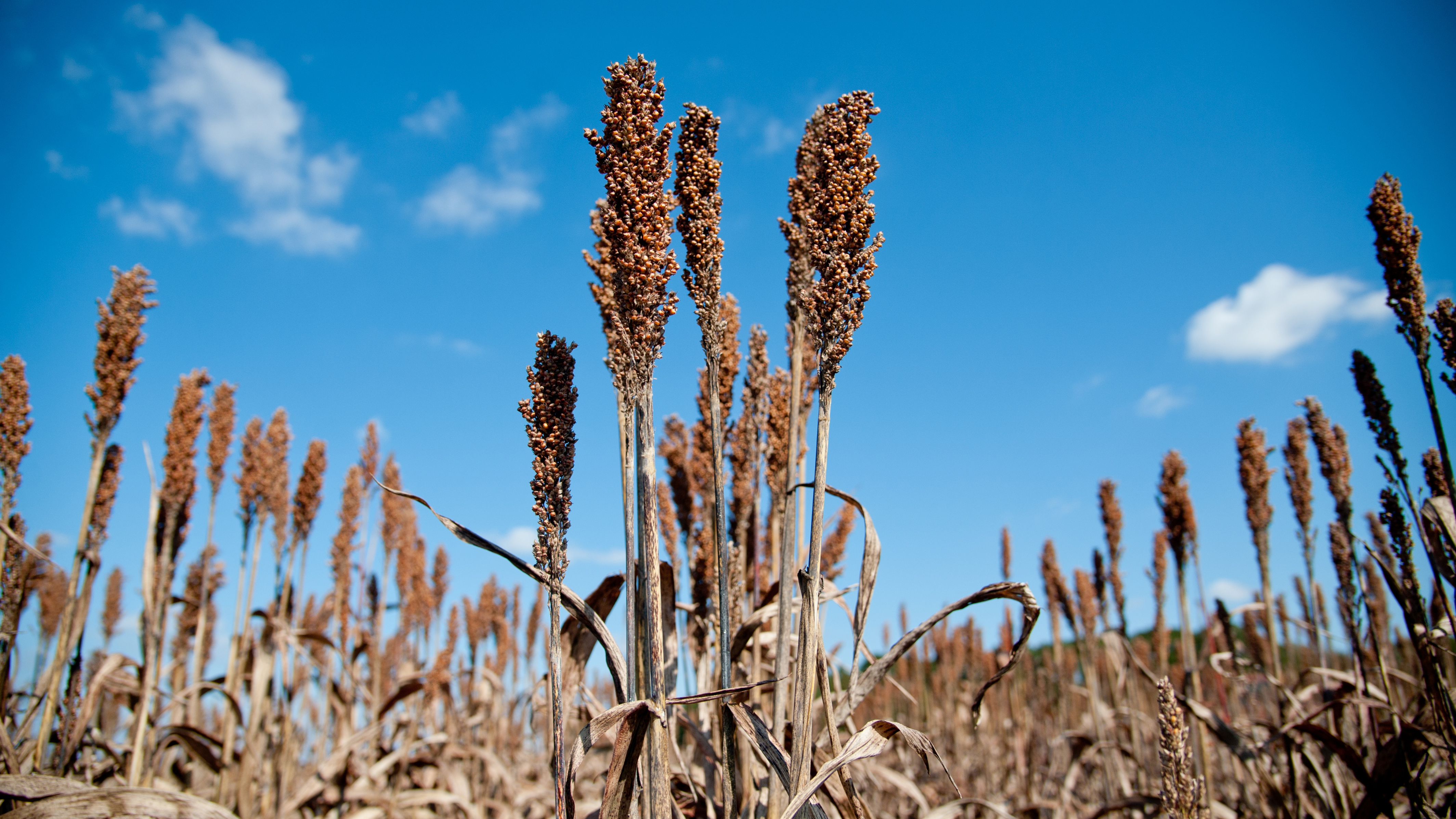Growing the Grain Industry

Solutions benefit both crop and animal producers.
For years, the poultry and livestock industry has been North Carolina’s largest source of agricultural income and jobs. But with that industry’s future here in peril because of a 200-million-bushel-a-year feed grain deficit, agricultural leaders from private industry, commodity groups, government and the College of Agriculture and Life Sciences went searching for a solution.
And that solution has proven to be a winner not just for livestock but also for crop producers looking for new opportunities.
Today, thanks to the North Carolina Feed Grain Initiative, North Carolina farmers are planting some 500,000 acres more in feed grains than they did in 2010. That has cut the amount of feed imported to the state from the Midwest grain belt and overseas by nearly 19 percent.
Being able to buy these grains locally has made a big difference – millions of dollars’ worth of a difference – for livestock and poultry producers, because it cuts the cost of transporting grains to feed North Carolina-grown animals.
When the initiative started four years ago, the 200 million bushels of feed grains brought into North Carolina represented more than two-thirds of the total consumed each year by the livestock industry. And the price of getting it here was soaring.
Dr. Terry Coffey is chief science and technology officer with the state’s – and the world’s – largest hog producer, Murphy Brown LLC. He explained that with feed grains constituting 60 to 70 percent of the cost of raising a hog for food production, the company was finding it less expensive to produce hogs in states closer to the feed-grain supply than to its headquarters in Warsaw, North Carolina.
“And if you look at the long run, if your major cost input is becoming more and more expensive relative to the cost of your competition, then your business will become economically unviable,” he added.
Keeping North Carolina poultry and livestock producers viable long term meant breaking the decades-old tradition of importing feed grains by rail and by ship and, instead, buying local.
But being able to buy local grains meant that farmers here needed to produce more local grains.
How to make that happen? From the College of Agriculture and Life Sciences’ standpoint, that meant launching an all-out research and outreach push to help growers understand how they could increase yields of grains they already grew and to identify other grain crops that might be profitable.
Sorghum, a corn-like grain often grown in deserts, seemed to be a possible match for the southern coastal plains’ sandy soils.
And so, in 2011, Murphy Brown teamed with the state Department of Agriculture and Consumer Services and several Cooperative Extension agents to begin a pilot program for North Carolina farmers wanting to try sorghum production.

In the meantime, Drs. Wes Everman, Ron Heiniger and Randy Weisz, all in the CALS Department of Crop Science, signed on to start testing the crop the coming season.
Murphy Brown and other agricultural companies began contracting with growers to buy the sorghum at attractive prices – prices so attractive that winter grower meetings with the Crop Science specialists and Extension agents were packed with interested farmers.
Everman, who guides the college’s sorghum-related efforts, recalled that “all of a sudden, we were filling rooms with 300 or 400 people wanting to hear about grain sorghum” – a situation he found “rather frightening.”
“Our estimates were that somewhere around 40,000 to 100,000 acres of sorghum were going to go in the ground that first year without us ever doing a lick of research,” he said.
To avoid crop failures, growers needed to have research-based information on everything from how far apart to plant their seeds to how to dry the crop before harvest.
So the NC State scientists completely changed their research plans, quickly pulling together comprehensive production guides and fact sheets and offering training seminars and webinars.
Meanwhile, a group of NC State economists – Drs. Nick Piggott, Michele Marra and Kelly Zering, as well as Extension Associate Mitchell Buck, all from the Department of Agricultural and Resource Economics – began preparing financial information and tools that would help growers make decisions about whether to grow sorghum and how to do so profitably.
Everman said, “The growers picked up on it very quickly, and the county Extension agents ran with it. That first year we had around 72,000 to 73,000 acres of sorghum – a tenfold increase in a single season, which is unheard of.”
Production went even higher in 2013, but the weather didn’t cooperate.
Many sorghum producers were rotating the crop into their fields after harvesting their winter wheat, but it was such a rainy spring that some of them couldn’t harvest the wheat on time, Everman said. That meant sorghum went into the fields later than it should have, and it suffered from diseases brought on by continued wet weather.
“All told, I think we topped 100,000 acres that year, but a lot of those acres weren’t successful in the eyes of the growers,” Everman said. “So this year, they planted probably half that.”
Still, Everman and agricultural economist Piggott think there is a good future for sorghum in the state.
“The future is encouraging for further expansion of feed grain production. The livestock producers are transforming into motivated purchasers of local feed grains,” Piggott said. “Importantly, they will pass the savings incurred from not having to procure feed grains from the Midwest on to the feed grain growers with higher local prices.”
Everman expects North Carolina sorghum production levels to vary for a few years but to level off at around 100,000 to 200,000 acres.
“Farmers are like everybody else – they are creatures of habit, and they want a reliable income,” he said. “So once we get sorghum to be reliable for them, they will buy in a little bit more.”
Making sorghum reliable means coming up with production strategies that ensure sorghum’s profitability. And that is the focus of ongoing work by College scientists, economists and Cooperative Extension agents.

They have found, for example, that rotating winter wheat with summer sorghum, rather than the traditional soybean crop, offers several advantages: Sorghum can yield a higher financial return than soybeans, and sorghum can also reduce problematic nematode and weed populations in fields that have been used for soybeans.
The college is also comparing hybrids, while Murphy Brown works with seed producers to generate varieties that are more suited to North Carolina conditions.
Scientists meanwhile are looking more deeply at weed and disease issues, Everman said, including how to best prevent or manage a disease that causes the grain to mold, which can sicken hogs. At the same time, CALS students are studying whether the biomass left in the field after sorghum is harvested binds up nitrogen so that wheat doesn’t get a good start – and, if that’s the case, then what can be done about it.
Students also are studying a natural chemical called sorgoleone, which sorghum exudes in its root hairs. The chemical inhibits the growth of plants near the sorghum, Everman explained, “so the students are looking at what impacts it has on the weed populations nearby.
“With our troubles with herbicide-resistant weeds like Palmer amaranth, is this another tool to help manage them in a rotation?” he asked. “But then detrimental effects on a double-crop wheat system have been shown.”
As CALS faculty work to expand the knowledge base surrounding sorghum, they are being joined by faculty from nearby states. Given what’s happened in North Carolina, Virginia Tech and Clemson universities have joined in, while people in Delaware and Maryland have expressed interest, Everman said.
As a young faculty member, Everman has found it exciting “to see NC State at the forefront of such an important issue – able to provide information that farmers needed when they needed it” and to anticipate the questions they’ll have about feed grains production in the future.”
At the other end of the spectrum, retiring professor Weisz said he’s pleased at the promise the initiative has helped create for North Carolina’s agricultural future. As he pointed out, the survival of the industry he has worked with for decades – small grains – is tied directly to the survival of animal agriculture here. “It is critical to wheat growers,” he said, “because about 50 percent of North Carolina’s wheat goes to the animal industry.”
Coffey also emphasized the important relationship of animal and crop production and the initiative’s impact on that relationship in North Carolina.
The initiative has “not just been a win for the livestock producers of this state, it’s also a win for the landowners and the farmers and related crop production industries,” he said. “And it can improve the economic picture in all of North Carolina because we can keep the money that we’ve been spending elsewhere on feed ingredients.
“I think it’s transforming agriculture in North Carolina,” he added. “I don’t think that’s an exaggeration.”
– Dee Shore
- Categories:


